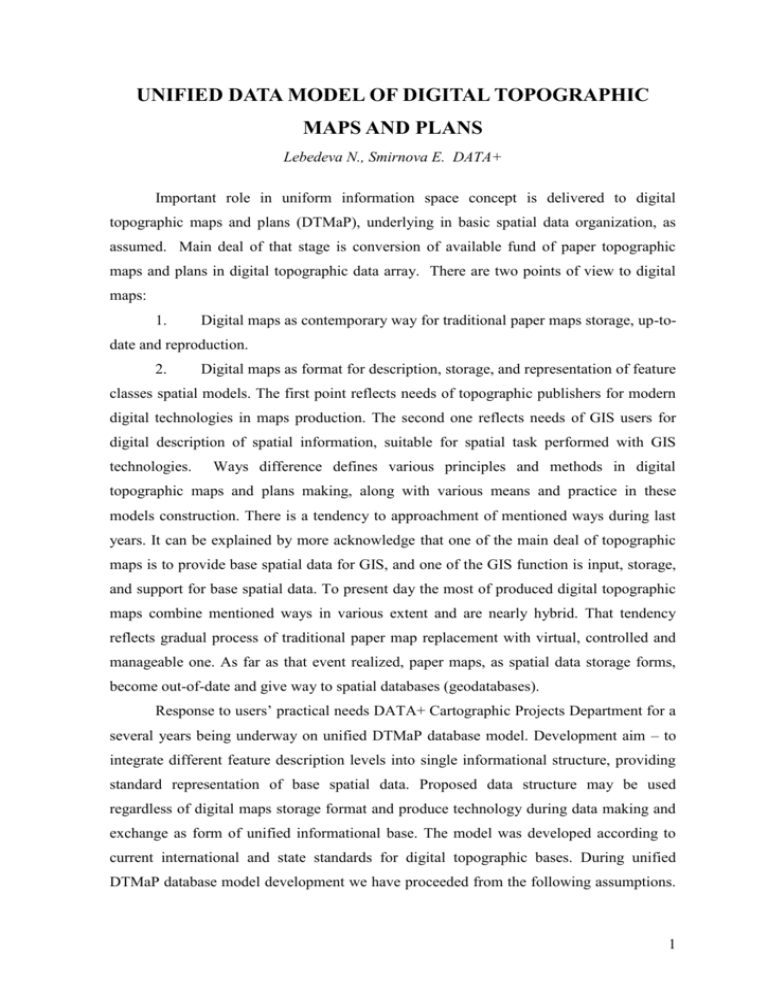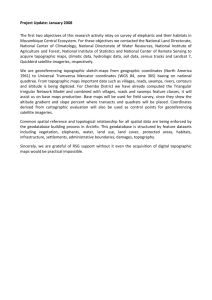unified data model of digital topographic maps and plans
advertisement

UNIFIED DATA MODEL OF DIGITAL TOPOGRAPHIC MAPS AND PLANS Lebedeva N., Smirnova E. DATA+ Important role in uniform information space concept is delivered to digital topographic maps and plans (DTMaP), underlying in basic spatial data organization, as assumed. Main deal of that stage is conversion of available fund of paper topographic maps and plans in digital topographic data array. There are two points of view to digital maps: 1. Digital maps as contemporary way for traditional paper maps storage, up-to- date and reproduction. 2. Digital maps as format for description, storage, and representation of feature classes spatial models. The first point reflects needs of topographic publishers for modern digital technologies in maps production. The second one reflects needs of GIS users for digital description of spatial information, suitable for spatial task performed with GIS technologies. Ways difference defines various principles and methods in digital topographic maps and plans making, along with various means and practice in these models construction. There is a tendency to approachment of mentioned ways during last years. It can be explained by more acknowledge that one of the main deal of topographic maps is to provide base spatial data for GIS, and one of the GIS function is input, storage, and support for base spatial data. To present day the most of produced digital topographic maps combine mentioned ways in various extent and are nearly hybrid. That tendency reflects gradual process of traditional paper map replacement with virtual, controlled and manageable one. As far as that event realized, paper maps, as spatial data storage forms, become out-of-date and give way to spatial databases (geodatabases). Response to users’ practical needs DATA+ Cartographic Projects Department for a several years being underway on unified DTMaP database model. Development aim – to integrate different feature description levels into single informational structure, providing standard representation of base spatial data. Proposed data structure may be used regardless of digital maps storage format and produce technology during data making and exchange as form of unified informational base. The model was developed according to current international and state standards for digital topographic bases. During unified DTMaP database model development we have proceeded from the following assumptions. 1 Sets of topographic maps and plans with different scale are not only pantogeographic information about area features, but common system of spatial description with different detail levels. Topographic maps of different scale are linked with each other and are supplemented each other. Topographic maps are produced according to common cartographic representation, collateral subordination, and concordance rules. DTMaP geodatabase building principles Common practice in producing digital topographic maps and plans by paper maps digitalization determines a set of principles underlying universal DTMaP data model. 1. Compliance scale and content principle DTMaP generalization extent for spatial and semantic information has to comply with scale of initial source. Therefore unified DTMaP data model has several descriptive levels for spatial and semantic information. Each level is a model of features, represented in maps of defined scale. Scale compliance designates a spatial generalization level for cartographic information in digital model. Accordance with scale is characterized by metric description accuracy of feature. Metric description accuracy, in its turn, depends on supported coordinates storage accuracy in database and on tolerance precision while creating and editing of features. In data model semantic compliance is tracking in set of feature semantic characteristics. Semantic characteristics are included in set of feature classification values or in set of attributive values. Feature classification values are consisting of description parameters enclosed into conventional sign. Attendant characteristics constitute qualitative or quantitative parameters of feature, displayed as map legend. Attendant characteristics are grouped into sets of attributive fields of the same type. While zooming in some of characteristics are included into feature conventional sign and excluded from attributive description accordingly. 2. Similarity principle. Similarity principle means that features on digital map are produced according to rules of cartographic image composition. In that sense feature model on digital map is similar to model on paper map of corresponding scale. Linear feature classes in database organize features displayed with line symbols on map; features displayed with out-of-scale conventional signs – by point feature classes, and grid signs – by polygonal feature classes. During spatial data visualization symbols similar to paper maps those are selected. 3. Succession principle Succession principle is a basis for building of classifier for DTMaP features and for digital data structure forming. While zooming in, detailing of spatial and semantic feature 2 characters happens, that determines classification principles for area features - from general to particular, from entire to part. Classification codes of low classification grade include semantic characteristics for more high classification grade. So succession maintained during coding and description of same features in different scale maps. Succession principle determines database structure invariability for different scale maps. Despite scale data are grouped into subject sets and feature classes according to subject headings of classifier and are described by standard template. 4. Compatibility principle Compatibility principal represent common coordinate and topologic area for all scales range. Coordinate compatibility should not be only physical it may be also virtual. Unified virtual coordinate spatium is provided with obligatory description for coordinate systems and projection parameters. Unified topology is provided with propriety of input topological data. 5. Continuity principle. Continuity principle is presuming: a) seamless storage of spatial data arrays without dividing into nomenclature sheets, and b) features integrity support with technical lines and polygons. Geodatabase model components Basic structure unit of geodatabase is a feature. Feature is a graphical way to represent object locality on map. Features are combined into features classes, and these – into features classes’ sets. Informational basic of DTMaP database structure are spatial and semantic characters of features. Spatial information Spatial information describes positional parameters of object locality. Locality form means object metrical characters and its topological correlation. Features are divided by localization method into point, line and polygonal feature classes. Depending on software used and storage format, topological correlations may be assigned in an explicit form with topology rules and be maintained automatically, or with requirements specification and controlled during input or edit. Semantic information All features quantity is described with quantity of qualitative and quantitative characters, which are used while displaying on map. Encoding system was developed for uniform presentation of semantic information. Classifier is an ordered quantity of 3 qualitative characters for features, which are used while displaying features on the map. Classifier has classification codes, that unambiguously determine semantic characters sets for feature Classifier’s information unit is 8 digit code. Each code position has information for feature. First positions determine adjuncts for theme groups in feature class sets. Next positions subscribe the depth of feature semantic description, used for conventional signs during visualization. Semantic characters, not included in classification code, submitted to separate attribute values. Characters, subject to coding, reference to common for DTMaP domens. Domen is a reference table containing ranges or legitimate values lists for attributes and their codes. Classifier and other attribute domens are designed for precising, adding and editing in special order if necessary. Characters not subject to coding – feature proper names or variables – are stores as attribute fields’ values. Metadata Metadata are the main component of DTMaP and have to be build, stored, distributed and supported as obligatory component for geodatabase International metadata for spatial data standard and its resulting Russian standard (Russia State Standard ISO 19115-2003) ensure it’s universality and uniformity. Data structure Data structure stores spatial and semantic information for features and is invariant to scale. Data structure defines unified data storage form and unambiguously determines: - features separation by classes in features classes sets; - method of spatial localization in feature classes; - attribute and attribute domens sets. DTMaP feature classifier is a key and a logical basis for database structure. Classifier is included into database structure as domain for map features. Geodatabase is a digital topographic data array repository, scale compliance. Feature class – the sum of similar local objects grouped by method of graphical presentation. Fig.1 Logical DTMaP database structure 4 Model execution forms 5 DTMaP database model purpose is a description of DTMaP data structure in systematic, formalized and unified form. Model structure description is supported with variety of formats. 1. Logical scheme of DTMaP data model with individual components is shown in Excel sheet format (Fig. 1). This data description form is a prototype of physical model and may be basis for organization of spatial data storage in a single structure. Logical model includes: classifier of DTMaP features, feature classes index for each dataset, attributive fields structure with parameters description (name, field type, width), total list of attributive fields and attributive domains. Fig.2 Data model scheme in Excel sheet 2. Geodatabase model description in UML notation of Visio environment with the aid of block-diagram design. Such a format allows disposing logical structure to special scale for realization in format of personal geodatabase ArcGIS or in format of DBMS geodatabase controlled by spatial servers (Fig.3). 6 3. Universal DTMaP geodatabase template (Fig. 4) includes predefined set of feature classes’ tables and attribute domens. Template may be used for loading spatial data from different sources in order to their unified representation. Previously it is necessary to bring to conformity description system of semantic information in sources with semantic system of considered model. This process may be automated with lookup tables of classification codes. Geodatabase structure may be converted into other spatial data storage format, for 7 example into shapefile. 4. Universal personal geodatabase template in exchange XML document format. In structure of unified DTMaP model, DATA+ maintain databases of following scales: 1 000 000 000 – for Russian Federation territory and adjacent countries, 500 000 – for RF territory, 200 000 - for most part of RF, 100 000, 50 000, 25 000 – for several regions of RF. Initial digital data were obtained from variety of sources, validated for topological propriety, checked for accuracy and features plenitude according to paper originals and were placed into physical data model template using specially designed software packages. Advantages of unified data model Unified database model allows: - optimize work with basic features, since classification and coding system is building up succession in semantic information during scale-to-scale transfer; - execute scalable features modeling in uniform information space design; - ensure universal data description for their identification and search. 8 9






